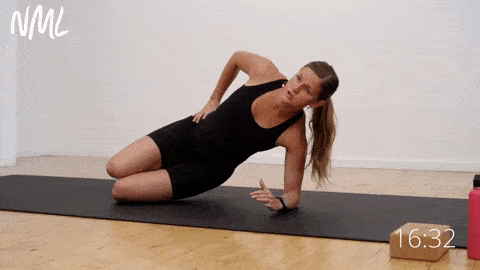 Buy Now →
Buy Now → 

Wondering if you’re ready to return to running or HIIT training after pregnancy? This postpartum fitness test is for you. Follow along with this guided workout video, designed to assess strength, balance and impact tolerance. These are good indicators that your body is ready to slowly resume high impact exercises, like HIIT training or running postpartum.
“When can you start working out again after having a baby?”
This is a common question in my DMs and email inbox, and as with most things related to pregnancy and postpartum, there isn’t a black and white answer.
Postpartum recovery depends on so many factors: how active the pregnancy was, what your fitness level was pre-pregnancy, what the labor was like, whether there was tearing or a c-section…every experience really is different.
So we’ve developed this postpartum assessment to determine readiness to return to high impact physical activity post-pregnancy.
Note: it’s recommended you wait at least 12 weeks after birth before attempting running or high impact exercise.
Before the 12-week mark, you can work on core repair with our Diastasis Recti Workout Videos and build strength and endurance with low impact strength training when you feel ready.
When you are 12 weeks postpartum (or more) and interested in adding impact back into your exercise routine, do this test first to assess your body’s readiness.

Every postpartum recovery period is different. Talk to your OB/GYN, physical therapist or midwife for medical clearance before starting exercise after birth, especially if you had any complications. I personally started doing postpartum core recovery exercises 2 weeks postpartum. Then I added in strength training workouts around 6 weeks postpartum. I slowly started adding in running and impact exercises around 15 weeks postpartum after passing this postpartum assessment.
Pelvic pain, heaviness or leakage during the exercises in this Postpartum Fitness Test is an indicator your body isn’t quite ready to return to high impact training. That doesn’t mean not ever, it just means not yet. I suggest returning to low impact strength training and coming back to try this again in a few weeks
I highly suggest strength training prior to running. Then take a fitness assessment like this one or Dr. Carrie Pagliano’s “Return to Run” check-list. I also followed a “Run/Walk” plan from my pelvic floor physical therapist, Dr. Sari at Motion MN. The key with running postpartum is to take it slow – run no more than every other day and gradually progress running volume. Pelvic Floor Dysfunction (PFD) has more to do with running volume than pelvic floor strength. If running feels uncomfortable, return to walking.
Exercise during the postpartum period can promote better sleep, lessen risk of postpartum depression, and boost energy. For me personally, exercise is something that made me feel like myself again.

Assess your readiness to return to HIIT training or running postpartum with this guided Postpartum Fitness Assessment.
This fitness test assesses strength, balance and impact tolerance: three indicators that your body is able to increase workout intensity.
Use this tool to assess your readiness for impact training at 12 weeks postpartum (or later). I recommend working through our postpartum workout plan and diastasis recti workout videos before attempting this fitness test.
I personally attempted this fitness test multiple times before adding impact back into my workouts, starting around 15 weeks postpartum.
You’ll know you have “passed” this assessment when you can complete all the exercises without symptoms like pelvic floor heaviness, pain or leakage. That’s when you can slowly start adding running and HIIT training back to your workout plan.
No equipment needed, just your bodyweight. Option to add a small elevated surface (such as a yoga block or thick book) for two exercises.

Follow along with the guided Postpartum Fitness Test on YouTube, led by certified personal trainer and certified postnatal fitness instructor, Lindsey Bomgren.
Your Workout Looks Like This:
CIRCUIT ONE: Strength
CIRCUIT TWO: Balance
CIRCUIT THREE: Impact

Targets: The entire core, including the deep transverse abs, upper abs, lower abs and lower back.

Targets: Gluteus medius (which lays on the outer edge of the buttocks and is responsible for stabilizing your pelvis), gluteus minimus (hip extension), pelvic floor muscles, obliques and core.
Clamshell exercises can help balance the muscular effort between your inner and outer thighs and your pelvic floor.

Targets: Legs, glutes, quads, hamstrings and core
Wall sits are a great way to build (and test) lower body strength. The unilateral (or single leg) version reveals muscle imbalances.

Targets: Glutes, hamstrings, hips and pelvic floor.

Targets: The posterior chain (backside of body) — glutes, hamstrings, lower back and core muscles. This single leg stability exercise will also challenge your balance.

Targets: Quads, hamstrings, glutes, hips, knees, pelvic floor and core.
If you don’t have a yoga block, you can sub a thick book or the bottom step of a staircase.

Targets: Hamstrings, glutes, hips and calves.

Targets: Pelvic floor, hips, glutes, quads, hamstrings and core.
This is an opportunity to test for any heaviness, pain or leakage during impact exercises.

Targets: Legs, quads, outer glutes (gluteus medius), inner thighs, calves and core.

Targets: Gluteus medius (which lays on the outer edge of the buttocks and is responsible for stabilizing your pelvis), gluteus minimus (hip extension), quads and abdominal muscles.

Targets: Quads, glutes, hips, core and pelvic floor.

 Buy Now →
Buy Now →  Buy Now →
Buy Now →  Buy Now →
Buy Now →  Buy Now →
Buy Now → 
This post includes affiliate links. I do earn a commission for products purchased using these links (at no additional cost to you). Thank you for supporting Nourish Move Love, making the content you see on this blog possible.